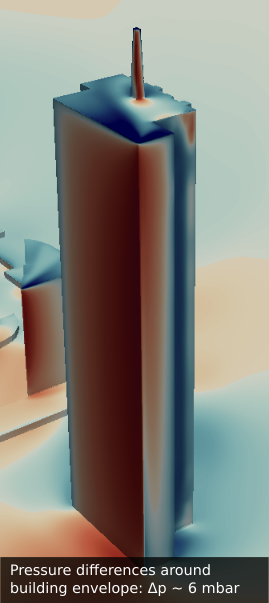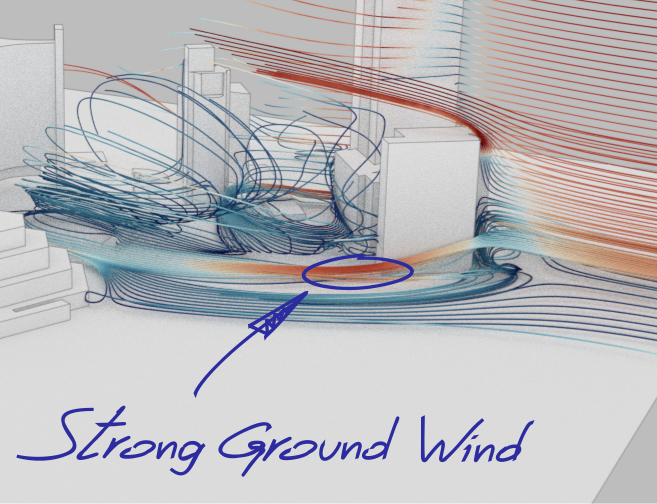Wind Assessment for Urban Planning and Architecture
In urban environments, microclimate and personal comfort are strongly affected by wind conditions, which in turn are influenced dramatically by high-rise buildings and other man-made structures. In this article, we will show the main effects that influence wind movement, briefly touch on what strong wind means for private persons (discomfort, danger) and business (customer avoidance), and on how to analyze urban development projects using CFD analysis.
Principal effects of wind movement in urban environments
Man-made structures in general and especially high rise buildings are obstacles for wind movement. Depending on their height and the profile that they expose towards the wind direction, a number of effects can occur:
- Downwards-deflection (“downdraft or downdraught effect”)
- Upwards-deflection causing high wind speed and pressure effects
- Flow through narrow spaces between buildings - “Venturi effect” - causing high wind speed and high turbulence
- Low velocity eddies on the downwind side of structures
- Counter-current effects (reversed or cross-wind direction)
The video below shows some of these effects schematically and demonstrates - on the basis of one of our CFD simulations - how they combine to create the complex flow patterns occurring in real urban environments:
In practice, these flow patterns are extremely difficult to predict without CFD simulation. Frequently, these effects can cause high velocity wind at ground level that can cause severe disturbances and be responsible for injuries and even fatal accidents. Wind at the height of a couple of dozen meters can easily be twice as strong as on ground level, turning a nice breeze into a nasty problem. In the simulation shown below, wind reported by the weather service as just below 40 km/h (fresh breeze) was amplified to above 55 km/h at pedestrian level due to deflection by buildings; 60 km/h are enough to push over a person.
Wind influence on businesses in cities

Even when nobody is getting hurt, wind can cause issues for businesses. If there is strong wind in an area, people will not linger, spend less time, and prefer to move on. At only 10 km/h, it becomes difficult to read a newspaper, not ideal if that shopping arcade or outdoor coffee bar you are planning lies in such an area. This is why wind can become a problem for shops and restaurants, or even for recreation areas like parks, places, fountains, etc., where people are expected to stay for some period of time. And if businesses cannot achieve their planned turnover, this will eventually impact the rent and ultimately the return of investment of the facility. In high rise buildings, open platforms, sky pools and similar installations can be impacted if these problems are not assessed in the planning phase and mitigated or avoided by making suitable changes.
Beyond tenants, the wind flow around a building also influences the operation costs. Frequent strong winds might impact the maintenance budget by necessitating frequent repairs. Also, the location of air ventilation in- and outlets can be critical for the operating costs of air conditioning. Having an outlet in a place that often experiences local high pressure conditions makes the fan work against a higher pressure differential, directly resulting in more electricity consumed. Conversely, having the inlet in the right place, the pressure differential will push the air into the inlet (respectively suck it out of the building at the outlet), helping you to save costs. A similar case can be made for cooling installations - if those are placed in areas with little air movement, for example, their performance will drop - just like a radiator with a broken fan.
To assess such effects before losses occur, CFD simulations can show the building envelope’s effect on the flow already in its planning phase, thus avoiding negative effects. As a technical demonstration, we show such a simulation in the video below. Unlike other tools on the market, our simulations are not restricted to a fixed cell size nor to simple rectangular buildings. As you can see in our simulation, we can deal with curved walls, holes, tunnels and - not shown in this video - even structures that slow down wind, like for example hedges, trees, perforated plates, etc., as well as sloped ground, hills, valleys, ridges and all sorts of terrain. The simulation shown below is down to a resolution of a couple of centimeters near walls, to capture all necessary details of the architecture in an area of roughly one million square meters.
In fact, this simulation shows an area where a pedestrian was seriously hurt by strong winds. The injury led to a lengthy lawsuit, with the court ruling that the effect could not have been foreseen ( link to German article). However, from our demonstration simulation, it looks like the effect should not have come as a surprise.
Urban wind: turning a problem into an asset
By far the best way to deal with wind in cities is to consider the impact of - not only but especially - high rise buildings on the flow pattern. In many cases, at least wind coming from the prevailing direction can be included in the planning when CFD engineers, construction engineers, urban planners and architects collaborate early in the process. Done right, wind can become an asset for a building: micro wind-turbines in the right place can generate power for the building, and placing air-inlets in high-pressure regions and outlets in low-pressure regions will help minimizing power consumption.
There are a number of solutions to solve issues at the pedestrian level, even after the planning stage. Vanes and awnings can be installed, and bushes and trees slow down wind and additionally provide shade in summer, raising the recreation value of public places. A particular charming approach, since it is a classic win-win solution, is to place a micro wind-turbine in the right spot. The turbine receives lots of wind, increasing its performance, and at the same time robs the flow of its momentum, making the situation safer for pedestrians.
Thinking even further, with drone delivery in cities on the horizon: UAVs (unmanned aerial vehicles) are often very light and therefore susceptible to strong wind. If you plan to have a landing / launching platform on a high rise building, it will be important to not only have it in a place that provides UAVs with calm enough conditions to land safely, but also to have safe approach corridors in varying wind conditions. Nobody wants a drone to smash into a building or - even worse - to cause human injury. Providing information about how to approach a place in a city in various wind conditions will improve safety, gain public trust, help to reach OTIF goals, minimize delivery times and help maximize the range of UAVs.
Urban microclimate beyond wind
Beyond the wind speed itself, the moisture (and heat radiation) also plays an important role for both the microclimate and human comfort. In our simulations, we can include the influence of moisture from sources like trees, parks, lakes and rivers, and thermal radiation, giving planners even more insight into the urban microclimate. With this approach, we can for example predict the perceived temperature in an urban park on a hot summer day with / without that fountain you might be thinking about, or assess the effect of a roof structure over a stadium.
Contact us if you want to know more!
Published:
